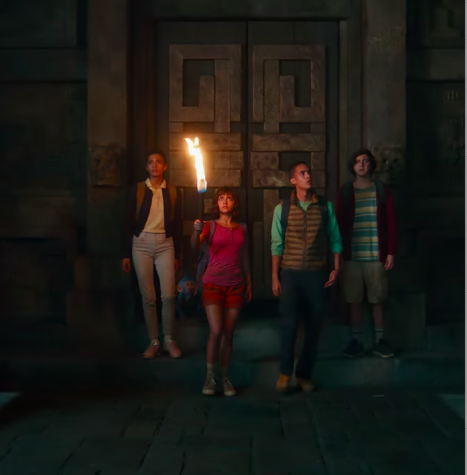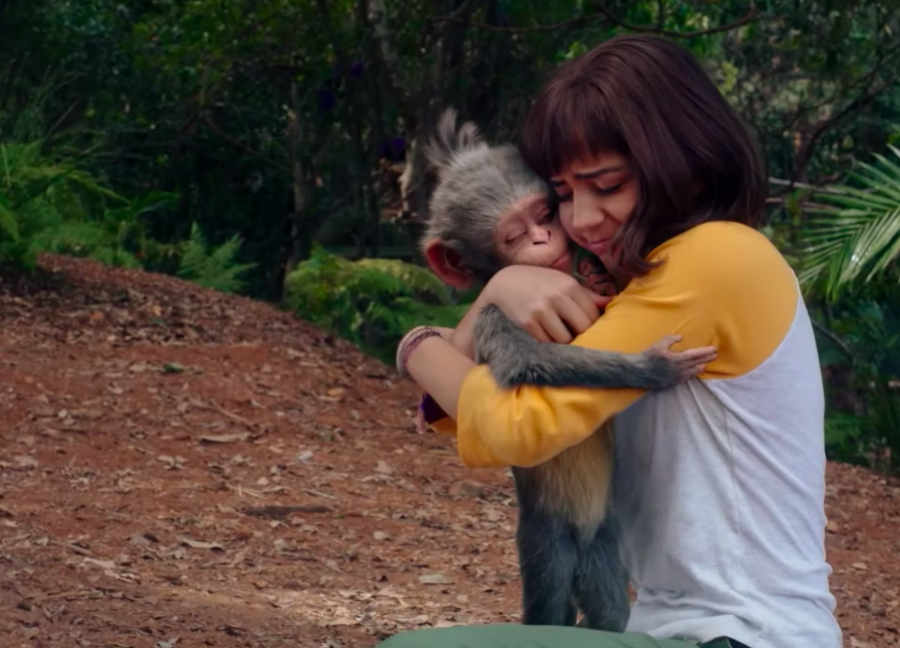Rediscovering childhood in “Dora and the Lost City of Gold”
Dora, now a teenager, hugs pet monkey Boots goodbye. “Dora and the Lost City of Gold” brings the original characters from the cartoon to the big screen with a new live-action look.
October 6, 2019
“Come on, vámanos, everybody let’s go!” shouts Dora.
This familiar song, alongside dozens of others, is more than some children’s introduction to Spanish; it’s a treasured part of many childhood experiences. So when news of a Dora movie came out, I was immediately intrigued. People’s ecstatic responses, of course, were mixed with the usual skepticism that questioned how the cartoon would render as a live-action film on the big screen, especially given the younger targeted audience.
With a multi-faceted approach, director James Bobin’s interpretation of the franchise incorporates plenty of self-deprecating clichés that poke fun at the original cartoon while still holding true to the central themes and messages. Despite receiving some initial ridicule, the movie still manages to appeal to a wide range of people. For younger audiences, it contains enough fantasy and adventure to keep them engaged in the movie. For teenage audiences, it’s a nostalgic blast back to simpler times. And for any and all ages, it’s a film jam-packed with more laugh-out-loud-moments than you can count.
“Dora and the Lost City of Gold” takes the cartoon six-year-old and transforms her into Isabella Moner’s rendition of a 16-year-old. Following the events of the cartoon series, Dora has been homeschooled by her parents in the Peruvian rainforest. When Dora’s parents leave in search of the lost Incan city of Parapata, they decide to send Dora to high school in LA with Diego, her cousin. This is short-lived, however, as Dora, Diego, and her classmates Sammy and Randy are soon kidnapped by treasure hunters who are after Dora’s parents’ research. Facing the obligatory challenges of treasure hunting in the jungle, the group navigates their way to the hidden city and their freedom.
The film starts off with what one might expect of a typical cartoon to live-action transition: Elementary-aged Dora and Diego driving around the jungle in a bright yellow, child-sized Jeep, an unconvincingly rendered CGI Boots, and a chorus of singing rocks, trees, animals, a backpack and a map. Luckily for audiences that might be turned off by another one of those films, this scene is revealed as simply being the childish imaginations of the pair, the first joking hint at the ridiculous premise of the original show.
This humorous, self-deprecating tone is further emphasized throughout the film with Dora’s mannerisms clashing with the brutal life of high school. Perhaps the most memorable of these is Dora’s tendency to break the fourth wall. In one scene, six-year-old Dora looks right at the camera—off into space for everyone else—and says, “Can you say ‘delicioso’? . . . Say ‘delicioso’!”
While Dora doesn’t carry this habit into her high school life, she does carry her seemingly endless stash of survival supplies. On her first day of school, Dora stops the whole security line as they find her emergency food kit, shelter, radio and GPS, among other things. Later on, after she is kidnapped, Dora pulls out a knife, earning a sarcastic “Oh, look: Dora brought a knife on the field trip, everybody” from her classmate Sammy. And, again eliciting much disdain from her classmates, Dora brings along her impromptu songwriting and animal imitations into every situation, whether it be trekking through dense jungle or going to the bathroom in it.

Dora, her cousin Diego, and their classmates navigate through jungle puzzles. The movie captures all the familiar tropes of the TV show with self-awareness of all the clichés.
Each of these things would fit perfectly in the original show, yet in the context of a live-action, seems to be completely ridiculous. But instead of cutting these out, Bobin uses them to create sort of an inside joke for ex-Dora-watchers, a subtle allusion to childhood entertainment masked behind humor. These also help the film remain true to its roots by finding the balance between reality and the magical world that children can get lost in.
The talking map and backpack lose their personification, instead becoming a practical navigation tool and an endless supply closet. At the same time though, there’s enough malleability in the realism of Dora’s world that Boots can exist as a cute, non-aging sidekick, and Swiper can exist as a clumsy, scheming villain who repeatedly smashes his face into a Jeep. This allows all of the distinctive and well-loved characters a reprise, but with a touch of live-action magic as well.
As in the original show, Dora’s exuberance is boundless. From the moment she steps onto campus, she smiles and waves at every stranger she passes, saying, “¡Hola! Soy Dora” even as they ignore her. In class, she shares her extensive knowledge on various topics, clearly enjoying school—a stark contrast from the bored students around her. And at the school dance, she takes her animal imitations to the dance floor, ushering in even more ridicule than before. All of this climaxes as Dora’s resolve finally collapses in a poignant scene where she faces how hopeless her optimism is, as well as how Diego is being targeted at school because of it. In the moment, the scene is powerful, but it does fall short in terms of follow-through in the rest of the movie: Dora’s behaviors remain, for all intents and purposes, the same. Though the message might be to continue acting like yourself no matter what, it isn’t reinforced enough.
Another message, however, does hit the mark more accurately. Starting from the beginning of the film, it is repeatedly stated that the search for Parapata isn’t a treasure-hunting mission; it’s an adventure of exploration for the sake of education and archaeology. As the plot progresses, this is further echoed in things like the antagonistic role of the actual treasure hunters. And as the climax arrives, Dora beats the jungle puzzle while the treasure hunters fail because she values water over gold. All this circles back to one of the most basic tenets of the original show, as seen in the title—“Dora the Explorer.” In the end, it creates a moral hierarchy with greed squarely at the bottom.
And while all these different elements highlight what brings the character to life, it’s all tied together by themes of positivity and inclusivity—the need to accept oneself among the judgemental nature of teenage life, even in the face of harsh critique and challenges. Further, despite the treasure-themed adventure, there is a strong emphasis on the importance of curiosity and the value of exploration of history over wealth. Although the principles might seem simple, the movie is able to hit on different tones that will interest audiences of all age groups. Each layer of the film captures another niche audience with the fantasy, message, tongue-in-cheek jokes and memorial of the original show all playing a part. And, of course, everything’s all tied up in a big, must-watch, Dora-esque bow.





